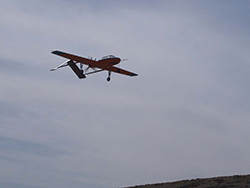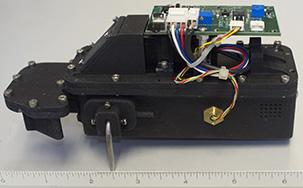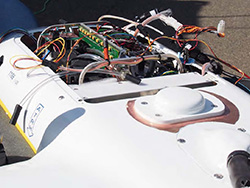A .gov website belongs to an official government organization in the United States.
A lock () or https:// means you've safely connected to the .gov website. Share sensitive information only on official, secure websites.
30 April 2014
A NOAA Special Early-Stage Experimental or Developmental (SEED) project bore fruit in early April as the very first test flights were conducted for new instruments designed to measure properties and climate effects of airborne fine particles ("aerosols") using the Manta Unmanned Aircraft System (UAS).
NOAA's Manta UAS can carry payloads of up to 12 pounds, on flights of up to 4.5 hours duration, speeds of 75 feet per second, and altitudes of up to 12,000 feet. The SEED grant enabled two NOAA labs (the Earth System Research Laboratory Chemical Sciences Division (CSD) and the Pacific Marine Environmental Laboratory (PMEL)) to expand the aerosol-measuring capabilities of the Manta.


Two new instruments for the Manta were developed at CSD. The Printed Optical Particle Spectrometer (POPS) and an upward-looking radiometer (ULR), together with three existing PMEL instruments for the Manta, permit mapping of aerosol properties (size, number concentration, light scattering and absorption, and chemical composition) and their effect on the climate system. The two CSD instruments are, in themselves, innovative in that they have a combined weight of only a little over 2 pounds and would easily fit inside a small shoebox. But when paired with the agile Manta UAS platform, they become a potentially powerful new tool for NOAA to address climate and air quality issues related to aerosols in remote and hard-to-access regions.


The POPS measures aerosol particle sizes, which are important for determining the interactions of the particles with light and hence their effects on climate. CSD Principal Investigator Ru-Shan Gao used CSD's three-dimensional printing capability (newly acquired using the SEED grant) to produce the structural components from the plastic raw starting material, and added new inexpensive lasers, optical detectors, electronics, and a miniaturized pump. Innovations of the design and fabrication approach led to not only the small size of the instrument, but also to its relatively low cost; the POPS is about a tenth the size – and a fifth of the price tag – of currently available instruments in its performance class. The ULR instrument measures the "radiant flux density" at the instrument's location. As the Manta carries the ULR through a layer of atmospheric particles, this measurement enables researchers to quantify how sunlight in the layer is scattered and absorbed, which is important for characterizing the role of aerosols in climate change. CSD's work under the SEED grant included designing electronics for the instruments that enabled autonomous operation on the Manta, and developing the needed data acquisition systems.
PMEL had already developed some particle-measuring capabilities for the Manta, such as a particle counter, a photometer for measuring black carbon, and a filter sampler for chemical analysis. The Manta engineering expertise of PMEL Principal Investigator Tim Bates and others at PMEL enabled a successful integration of CSD's new instruments onto the platform. The addition of the CSD instruments filled key measurement gaps in the Manta payload.


The first test flights of the new instruments took place in early April at the Yakima training grounds in the state of Washington. The PIs, along with their team from CSD and PMEL, took home a wealth of ideas for getting the hardware and software ready for its first science flights. Science readiness of the complete payload suite will be tested in a second series of test flights later this year.

The Arctic is a region that is considered to be particularly vulnerable to climate change. Arctic sea ice has reached historic lows in recent years, a very visible indicator of warming. Aerosol particles – one of the largest sources of uncertainty in climate model predictions of future climate – are a key factor in this region. Pollutants are transported from lower latitudes into the Arctic atmosphere, leading to thick aerosol layers known as "Arctic haze." The haze plays a strong role in Arctic warming in a direct way by changing how the sun's radiation interacts with the atmosphere and the ground, as well as in indirect ways by causing changes in clouds. The researchers hope that the newly outfitted Manta will be just the ticket to understanding how aerosol particles are affecting this remote, vast, and very difficult-to-reach region.